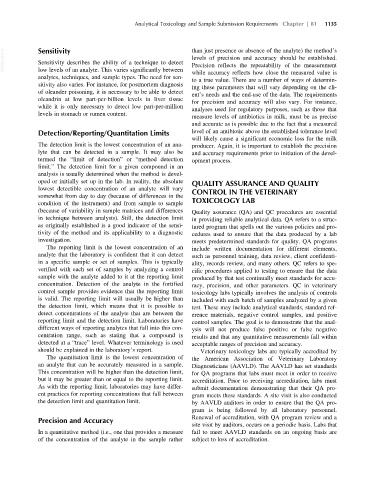Page 1204 - Veterinary Toxicology, Basic and Clinical Principles, 3rd Edition
P. 1204
Analytical Toxicology and Sample Submission Requirements Chapter | 81 1135
VetBooks.ir Sensitivity than just presence or absence of the analyte) the method’s
levels of precision and accuracy should be established.
Sensitivity describes the ability of a technique to detect
Precision reflects the repeatability of the measurement
low levels of an analyte. This varies significantly between
while accuracy reflects how close the measured value is
analytes, techniques, and sample types. The need for sen-
to a true value. There are a number of ways of determin-
sitivity also varies. For instance, for postmortem diagnosis
ing these parameters that will vary depending on the cli-
of oleander poisoning, it is necessary to be able to detect
ent’s needs and the end-use of the data. The requirements
oleandrin at low part-per-billion levels in liver tissue
for precision and accuracy will also vary. For instance,
while it is only necessary to detect low part-per-million
analyses used for regulatory purposes, such as those that
levels in stomach or rumen content.
measure levels of antibiotics in milk, must be as precise
and accurate as is possible due to the fact that a measured
Detection/Reporting/Quantitation Limits level of an antibiotic above the established tolerance level
will likely cause a significant economic loss for the milk
The detection limit is the lowest concentration of an ana- producer. Again, it is important to establish the precision
lyte that can be detected in a sample. It may also be and accuracy requirements prior to initiation of the devel-
termed the “limit of detection” or “method detection opment process.
limit.” The detection limit for a given compound in an
analysis is usually determined when the method is devel-
oped or initially set up in the lab. In reality, the absolute QUALITY ASSURANCE AND QUALITY
lowest detectible concentration of an analyte will vary CONTROL IN THE VETERINARY
somewhat from day to day (because of differences in the TOXICOLOGY LAB
condition of the instrument) and from sample to sample
(because of variability in sample matrices and differences Quality assurance (QA) and QC procedures are essential
in technique between analysts). Still, the detection limit in providing reliable analytical data. QA refers to a struc-
as originally established is a good indicator of the sensi- tured program that spells out the various policies and pro-
tivity of the method and its applicability to a diagnostic cedures used to ensure that the data produced by a lab
investigation. meets predetermined standards for quality. QA programs
The reporting limit is the lowest concentration of an include written documentation for different elements,
analyte that the laboratory is confident that it can detect such as personnel training, data review, client confidenti-
in a specific sample or set of samples. This is typically ality, records review, and many others. QC refers to spe-
verified with each set of samples by analyzing a control cific procedures applied to testing to ensure that the data
sample with the analyte added to it at the reporting limit produced by that test continually meet standards for accu-
concentration. Detection of the analyte in the fortified racy, precision, and other parameters. QC in veterinary
control sample provides evidence that the reporting limit toxicology labs typically involves the analysis of controls
is valid. The reporting limit will usually be higher than included with each batch of samples analyzed by a given
the detection limit, which means that it is possible to test. These may include analytical standards, standard ref-
detect concentrations of the analyte that are between the erence materials, negative control samples, and positive
reporting limit and the detection limit. Laboratories have control samples. The goal is to demonstrate that the anal-
different ways of reporting analytes that fall into this con- ysis will not produce false positive or false negative
centration range, such as stating that a compound is results and that any quantitative measurements fall within
detected at a “trace” level. Whatever terminology is used acceptable ranges of precision and accuracy.
should be explained in the laboratory’s report. Veterinary toxicology labs are typically accredited by
The quantitation limit is the lowest concentration of the American Association of Veterinary Laboratory
an analyte that can be accurately measured in a sample. Diagnosticians (AAVLD). The AAVLD has set standards
This concentration will be higher than the detection limit, for QA programs that labs must meet in order to receive
but it may be greater than or equal to the reporting limit. accreditation. Prior to receiving accreditation, labs must
As with the reporting limit, laboratories may have differ- submit documentation demonstrating that their QA pro-
ent practices for reporting concentrations that fall between gram meets these standards. A site visit is also conducted
the detection limit and quantitation limit. by AAVLD auditors in order to ensure that the QA pro-
gram is being followed by all laboratory personnel.
Renewal of accreditation, with QA program review and a
Precision and Accuracy
site visit by auditors, occurs on a periodic basis. Labs that
In a quantitative method (i.e., one that provides a measure fail to meet AAVLD standards on an ongoing basis are
of the concentration of the analyte in the sample rather subject to loss of accreditation.

